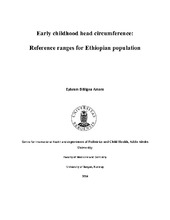| dc.description.abstract | Background: Hydrocephalus is a condition of increased volume of cerebrospinal fluid commonly associated with impaired brain function. It is more common in developing countries and mostly frequently in children. One can expect 3000-6000 new cases of hydrocephalus annually in Ethiopia. Head circumference (HC) is commonly increased in these children and its measurement is a simple, quick and inexpensive method of screening for hydrocephalus. Early treatment, which is now available in Ethiopia, prevents or reduces the development of malfunction. Since early treatment now has become available in Ethiopia, we were motivated to establish such a method in the country. Aims of the study: The aim of this study is to develop reference ranges for HC in Ethiopian infants and compare this reference with the existing WHO standard. Materials and methods: This was a prospective cross-sectional study approved by the ethics review board. Children age 0-24 months attending the mother-and-child clinic primarily for vaccination program in Addis Ababa and four other main cities of Ethiopia, were recruited to the study after informed consent. Hydrocephalus or having been treated for hydrocephalus and other obvious diseases including malnutrition were not included, nor were infants without documented date of birth. A soft measurement tape was used to measure the circumference in cm in a standardized way. In addition to measuring HC age, date of birth, ethnicity, medical history were recorded for all participants. The LMS method was used to establish the reference graphs for boys and girls. These graphs were compared with WHO and Norwegian charts both by calculating absolute differences and comparing percentile lines using 95%CI. Results: 4025 children (2046 boys and 1979 girls) under 24 months were included in the study. The established reference ranges for boys and girls had a similar pattern to those found in the WHO and Norwegian studies. The 50th and 97th percentiles of the WHO charts were found to be significantly below the corresponding Ethiopian lines. The 3rd and 50th Norwegian percentiles were significantly above the corresponding Ethiopian lines. Conclusion: Ethiopian reference ranges for children 0-24 months of age were found to be significantly different from those established by WHO, suggesting the use of local reference for the screening for hydrocephalus. We speculate that a trend towards lower 3- percentile values with advancing age in the Ethiopian children may be due to nutritional or environmental reasons. | en_US |
